Low-Rate Non-Intrusive Load Disaggregation with Graph Shift Quadratic Form Constraint
Abstract
:1. Introduction
1.1. State of the Art in NILM
1.2. Contributions
- We pose the power disaggregation as a MF problem and integrate the technical idea of the event-based approaches into the MF problem, i.e., GSQF-APD is actually a hybrid NILM, which can reduce the training complexity.
- The graph shift quadratic form is introduced as a new regularization term, which outperforms the Laplacian-based approach in classification accuracy.
- We separate the appliances from the aggregate power signal one by one in a descending order, which reduces the coverage to low power appliances, and obviously improves the disaggregation accuracy.
- Compared with other algorithms that require a training process, GSQF-APD is less dependent on training data.
2. Methodology
2.1. Problem Statement
2.2. Graph Shift Quadratic Form Constrained Active Power Disaggregation
2.3. Two-Step Iterative Optimization Method
3. Experiment and Results
3.1. Performance Metrics
3.2. Experimental Results and Discussion
- (1)
- Effectiveness of GSQF-APD algorithm. In the experiment, we use the aggregated active power readings of House 1 and House 2 from REDD dataset, and respectively select a period of time without any invalid intervals to demonstrate the disaggregation performance of the proposed algorithm. The disaggregation result of GSQF-APD for two typical days of House 2 is shown in Figure 2.
- (2)
- Comparison of two GSP-based methods, GSQF-APD and GLQF-APD [40]. In this experiment, we compare the two approaches in two sections. In the first section, we compare the classification performance for House 2 of the two methods. The corresponding results are reported in Figure 4, where the precision, recall, and F-Measure are reported in Figure 4a–c, respectively. The values are related to Table 1, which is very informative about details of each appliance’s classification result and the absolute improvement of three classification metrics. Firstly, contrasting Step 1 and Step 2 of the GSQF-APD algorithm, we can see that the Step 2 performs better than Step 1 in classification accuracy, where the precision, recall, and F-measure of most appliances are significantly improved. It further illustrates that Step 2 simultaneously reduces the FP and FN events that occurred in Step 1 by using the SA algorithm to refine the results. Then, we observe that although the GLQF-APD algorithm (Solution 1 and Solution 2) produces a relatively high precision, it leads to significantly worse recall and F-measure performance than the GSQF-APD algorithm, especially for the low power appliances, for instance, lighting. In addition, note that for the GLQF-APD algorithm, the recall does not improve in Solution 2 compared with Solution 1, which indicates that the FN events are not decreased. Overall, our proposed GSQF-APD shows that average F-measure value for House 2 is 0.87, which is better than the GLQF-APD approach that shows F = 0.75 for the same house. Thus, we can conclude that the proposed method is more accurate than GLQF-APD in classification.
- (3)
- Comparison with the state-of-the-art NILM approaches: First, a comparison of average classification accuracy of GSQF-APD with GLQF-APD and SVM-based approach for House 2 is shown in Figure 6. We can see that the two GSP-based algorithms, GSQF-APD and GLQF-APD, achieve higher accuracy than the SVM-based method, especially when the ratio of training data is small (under 8%), the difference of classification accuracy can exceed 20%. This observation demonstrates that the GSP-based approach reduces the dependence on training data compared with the SVM-based method. Furthermore, the GSQF-APD approach that uses the graph shift-based regularization term outperforms the GLQF-APD approach that introduces the Laplacian quadratic form as a regularization term. The classification accuracy gap between GSQF-APD and GLQF-APD varies from 2% to 13%. Note that the curve obtained by the SVM-based method presents a relatively obvious step-characteristic, which is due to the fact that training data in a certain interval contains the same number of useful labels.
4. Conclusions and Future Work
Acknowledgments
Author Contributions
Conflicts of Interest
References
- Godina, R.; Rodrigues, E.M.G.; Pouresmaeil, E.; Matias, J.C.O.; Catalao, J.P.S. Model predictive control home energy management and optimization strategy with demand response. Appl. Sci. 2018, 8, 408. [Google Scholar] [CrossRef]
- Ariosto, T.; Memari, A.M. Comparative study of energy efficiency of glazing systems for residential and commercial buildings. In Proceedings of the Architectural Engineering Conference, State College, PA, USA, 3–5 April 2013; pp. 409–418. [Google Scholar]
- Armel, K.C.; Gupta, A.; Shrimali, G.; Albert, A. Is disaggregation the holy grail of energy efficiency? The case of electricity. Energy Policy 2013, 52, 213–234. [Google Scholar] [CrossRef]
- Hart, G.W. Nonintrusive appliance load monitoring. IEEE Proc. 1992, 80, 1870–1891. [Google Scholar] [CrossRef]
- Mocanu, E.; Nguyen, P.H.; Gibescu, M. Energy disaggregation for real-time building flexibility detection. In Proceedings of the IEEE Power and Energy Society General Meeting (PESGM), Boston, MA, USA, 17–21 July 2016. [Google Scholar]
- Abubakar, I.; Khalid, S.; Mustafa, M.; Sharee, H.; Mustapha, M. Application of load monitoring in appliances energy management—A review. Renew. Sustain. Energy Rev. 2017, 67, 235–245. [Google Scholar] [CrossRef]
- Dinesh, C.; Nettasinghe, B.W.; Godaliyadda, R.I. Residential appliance identification based on spectral information of low frequency smart meter measurements. IEEE Trans. Smart Grid 2016, 7, 2781–2792. [Google Scholar] [CrossRef]
- Figueiredo, M.; Ribeiro, B.; Almeida, A.D. Electrical signal source separation via nonnegative tensor factorization using on site measurements in a smart home. IEEE Trans. Instrum. Meas. 2014, 63, 364–373. [Google Scholar] [CrossRef]
- Xu, Y.; Milanović, J.V. Artificial-intelligence-based methodology for load disaggregation at bulk supply point. IEEE Trans. Power Syst. 2015, 30, 795–803. [Google Scholar] [CrossRef]
- Wichakool, W.; Avestruz, A.T.; Cox, R.W. Modeling and estimating current harmonics of variable electronic loads. IEEE Trans. Power Electron. 2009, 24, 2803–2811. [Google Scholar] [CrossRef]
- Wichakool, W.; Remscrim, Z.; Orji, U.A.; Leeb, S.B. Smart metering of variable power loads. IEEE Trans. Smart Grid 2015, 6, 189–198. [Google Scholar] [CrossRef]
- Hassan, T.; Javed, F.; Arshad, N. An empirical investigation of V-I trajectory based load signatures for non-intrusive load monitoring. IEEE Trans. Smart Grid 2014, 5, 870–878. [Google Scholar] [CrossRef]
- Wang, L.; Chen, X.; Wang, G. Non-intrusive load monitoring algorithm based on features of V-I trajectory. Electr. Power Syst. Res. 2018, 157, 134–144. [Google Scholar] [CrossRef]
- Henao, N.; Agbossou, K.; Kelouwani, S.; Dubé, Y.; Fournier, M. Approach in nonintrusive type I load monitoring using subtractive clustering. IEEE Trans. Smart Grid 2017, 8, 812–821. [Google Scholar] [CrossRef]
- Makonin, S.; Popowich, F.; Bajić, I.V.; Gill, B.; Bartram, L. Exploiting HMM sparsity to perform online real-time nonintrusive load monitoring. IEEE Trans. Smart Grid 2016, 7, 2575–2585. [Google Scholar] [CrossRef]
- Kong, S.; Kim, Y.; Ko, R.; Joo, S.K. Home appliance load disaggregation using cepstrum-smoothing-based method. IEEE Trans. Consum. Electron. 2015, 61, 24–30. [Google Scholar] [CrossRef]
- Chang, H.H.; Lee, M.C.; Lee, W.J.; Chien, C.L.; Chen, N. Feature extraction-based hellinger distance algorithm for nonintrusive aging load identification in residential buildings. IEEE Trans. Ind. Appl. 2016, 52, 2031–2039. [Google Scholar] [CrossRef]
- Gillis, J.M.; Chung, J.A.; Morsi, W.G. Designing new orthogonal high order wavelets for non-intrusive load monitoring. IEEE Trans. Ind. Electron. 2018, 65, 2578–2589. [Google Scholar] [CrossRef]
- Laughman, C.; Lee, K.; Cox, R.; Shaw, S.; Leeb, S.; Norford, L.; Armstrong, P. Power signature analysis. IEEE Power Energy Mag. 2003, 1, 56–63. [Google Scholar] [CrossRef]
- Department Energy Climate Change. Smart Metering Equipment Technical Specifications Version 2; UK Government: London, UK, 2013.
- Elburg, H.V. Dutch Energy Savings Monitor for the Smart Meter; Rijksdienst Voor Ondernemend Nederland: Assen, The Netherland, 2014. [Google Scholar]
- Liang, J.; Ng, S.K.K.; Kendall, G.; Cheng, J.W.M. Load signature study-part I: Basic concept, structure, and methodology. IEEE Trans. Power Deliv. 2010, 25, 551–560. [Google Scholar] [CrossRef]
- Yang, C.C.; Soh, C.S.; Yap, V.V. A systematic approach in appliance disaggregation using k-nearest neighbours and naive Bayes classifiers for energy efficiency. Energy Effic. 2018, 11, 239–259. [Google Scholar] [CrossRef]
- Biansoongnern, S.; Plangklang, B. Nonintrusive load monitoring (NILM) using an Artificial Neural Network in embedded system with low sampling rate. In Proceedings of the 13th International Conference on Electrical Engineering/Electronics, Computer, Telecommunications and Information Technology (ECTI-CON), Chiang Mai, Thailand, 28 June–1 July 2016; pp. 1–4. [Google Scholar]
- Liao, J.; Elafoudi, G.; Stankovic, L.; Stankovic, V. Non-intrusive appliance load monitoring using low-resolution smart meter data. In Proceedings of the IEEE International Conference on Smart Grid Communications (SmartGridComm), Venice, Italy, 3–6 November 2014; pp. 535–540. [Google Scholar]
- Gillis, J.M.; Morsi, W.G. Non-intrusive load monitoring using semi-supervised machine learning and wavelet design. IEEE Trans Smart Grid 2017, 8, 2648–2655. [Google Scholar] [CrossRef]
- Giri, S.; Berges, M. An energy estimation framework for event-based methods in Non-Intrusive Load Monitoring. Energy Convers. Manag. 2015, 90, 488–498. [Google Scholar] [CrossRef]
- Kim, H.; Marwah, M.; Arlitt, M.; Lyon, G.; Han, J. Unsupervised disaggregation of low frequency power measurements. In Proceedings of the 11th SIAM International Conference on Data Mining, Mesa, AZ, USA, 28–30 April 2011; pp. 747–758. [Google Scholar]
- Parson, O.; Ghosh, S.; Weal, M.; Rogers, A. An unsupervised training method for nonintrusive appliance load monitoring. Artif. Intell. 2014, 217, 1–19. [Google Scholar] [CrossRef]
- Bonfigli, R.; Principi, E.; Fagiani, M. Non-intrusive load monitoring by using active and reactive power in additive Factorial Hidden Markov Models. Appl. Energy 2017, 208, 1590–1607. [Google Scholar] [CrossRef]
- Johnson, M.J.; Willsky, A.S. Bayesian nonparametric hidden semi-Markov models. J. Mach. Learn. Res. 2013, 14, 673–701. [Google Scholar]
- Aiad, M.; Peng, H.L. Unsupervised approach for load disaggregation with devices interactions. Energy Build. 2016, 116, 96–103. [Google Scholar] [CrossRef]
- Kong, W.; Dong, Z.Y.; Hill, D.J. A hierarchical hidden Markov model framework for home appliance modelling. IEEE Trans. Smart Grid 2016. [Google Scholar] [CrossRef]
- Kolter, J.Z.; Batra, S.; Ng, A.Y. Energy disaggregation via discriminative sparse coding. In Proceedings of the 24th Annual Conference on Neural Information Processing Systems, Vancouver, BC, Canada, 6–9 December 2010; pp. 1153–1161. [Google Scholar]
- Singh, S.; Majumdar, A. Deep sparse coding for non-intrusive load monitoring. IEEE Trans. Smart Grid 2017. [Google Scholar] [CrossRef]
- Basu, K.; Debusschere, V.; Douzal-Chouakria, A. Time series distance-based methods for non-intrusive load monitoring in residential buildings. Energy Build. 2015, 96, 109–117. [Google Scholar] [CrossRef]
- Shuman, D.I.; Narang, S.K.; Frossard, P. The emerging field of signal processing on graphs: Extending high-dimensional data analysis to networks and other irregular domains. IEEE Signal Process. Mag. 2013, 30, 83–98. [Google Scholar] [CrossRef]
- Sandryhaila, A.; Moura, J.M.F. Discrete signal processing on graphs: Frequency analysis. IEEE Trans. Signal Process. 2014, 62, 3042–3054. [Google Scholar]
- Sandryhaila, A.; Moura, J. Classification via regularization on graphs. In Proceedings of the IEEE Global Conference on Signal and Information Processing (GlobalSIP), Austin, TX, USA, 3–5 December 2013; pp. 495–498. [Google Scholar]
- He, K.; Stankovic, L.; Liao, J. Non-intrusive load disaggregation using graph signal processing. IEEE Trans. Smart Grid 2016. [Google Scholar] [CrossRef]
- Zhao, B.; Stankovic, L.; Stankovic, V. On a training-less solution for non-intrusive appliance load monitoring using graph signal processing. IEEE Access 2016, 4, 1784–1799. [Google Scholar] [CrossRef]
- Rahimpour, A.; Qi, H.; Fugate, D. Non-intrusive energy disaggregation using non-negative matrix factorization with sum-to-k constraint. IEEE Trans. Power Syst. 2017, 32, 4430–4441. [Google Scholar] [CrossRef]
- Chung, F.R.K. Spectral Graph Theory; American Mathematical Society (AMS): Providence, RI, USA, 1996. [Google Scholar]
- Püschel, M.; Moura, J.M.F. Algebraic signal processing theory: Foundation and 1-D time. IEEE Trans. Signal Process. 2008, 56, 3572–3585. [Google Scholar] [CrossRef]
- Püschel, M.; Moura, J.M.F. Algebraic signal processing theory: 1-D space. IEEE Trans. Signal Process. 2008, 56, 3586–3599. [Google Scholar] [CrossRef]
- Boyd, S.; Vandenberghe, L. Quadratic optimization problems. In Convex Optimization; Cambridge University Press: New York, NY, USA, 2009; pp. 166–170. [Google Scholar]
- Bonfigli, R.; Squartini, S.; Fagiani, M.; Piazza, F. Unsupervised algorithms for non-intrusive load monitoring: An up-to-date overview. In Proceedings of the IEEE 15th International Conference on Environment and Electrical Engineering (EEEIC), Rome, Italy, 10–13 June 2015; pp. 1175–1180. [Google Scholar]
- Kolter, J.; Johnson, M. REDD: A public data set for energy disaggregation research. In Proceedings of the Workshop on Data Mining Applications in Sustainability, San Diego, CA, USA, 21–24 August 2011; pp. 1–6. [Google Scholar]
- Egarter, D.; Pöchacker, M.; Elmenreich, W. Complexity of power draws for load disaggregation. Comput. Sci. 2015, arXiv:1501.02954. [Google Scholar]
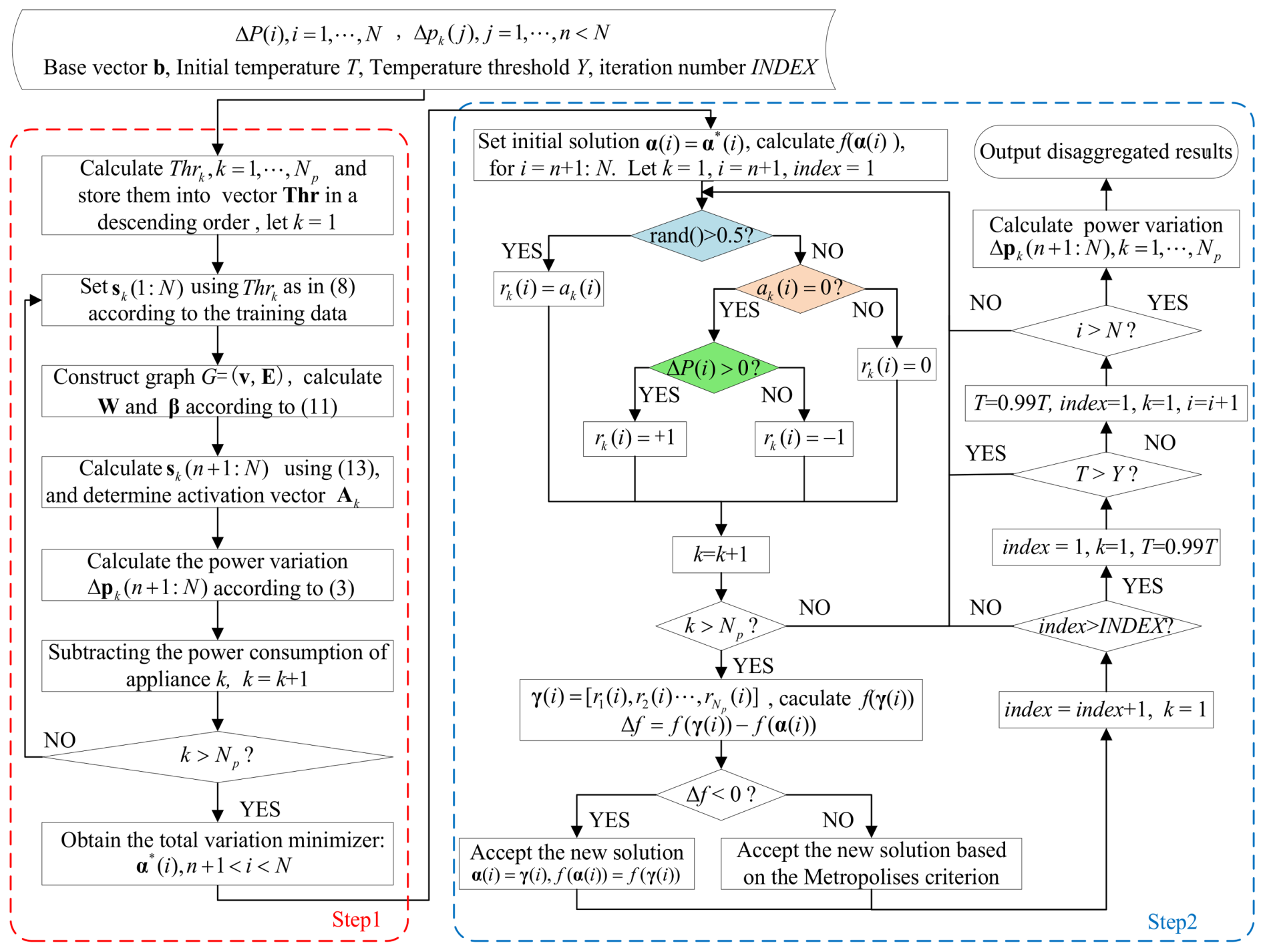

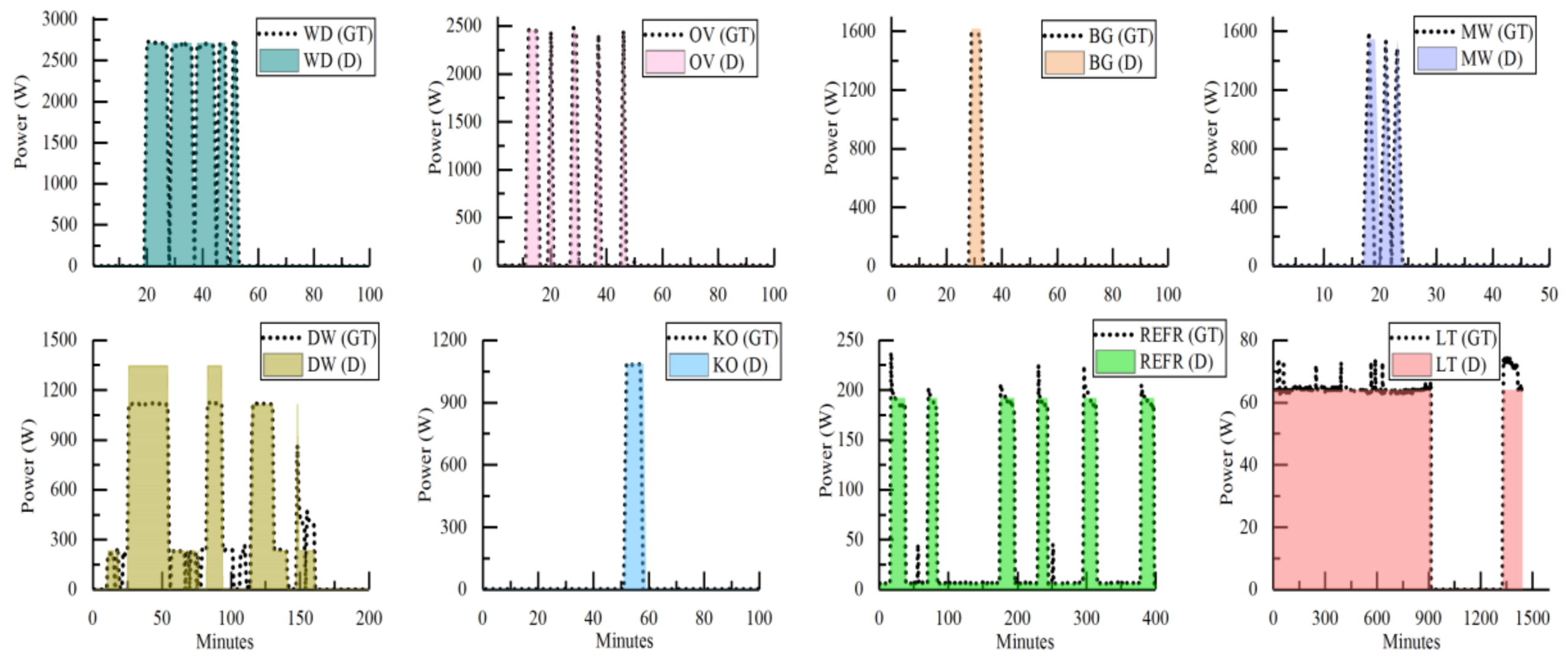
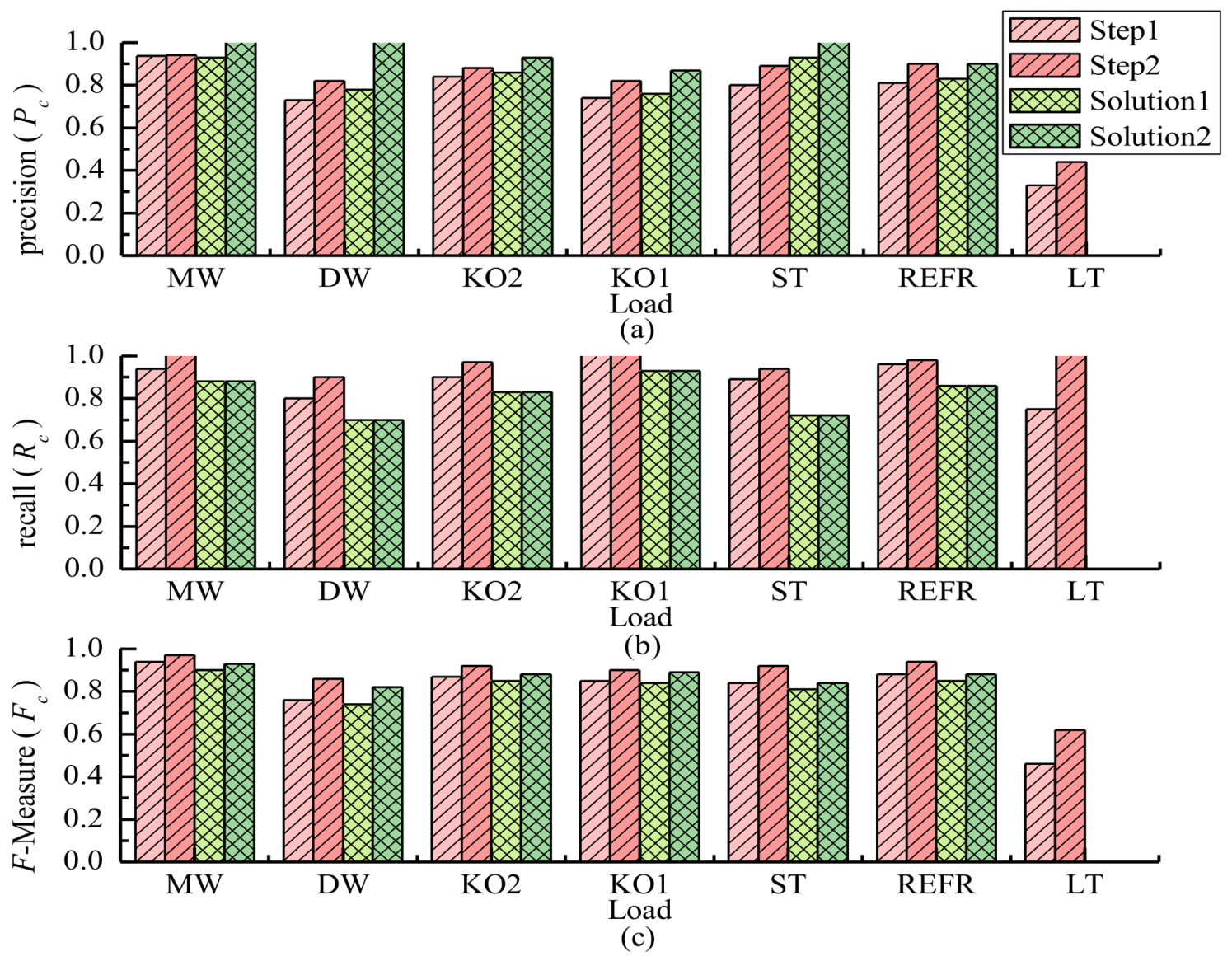
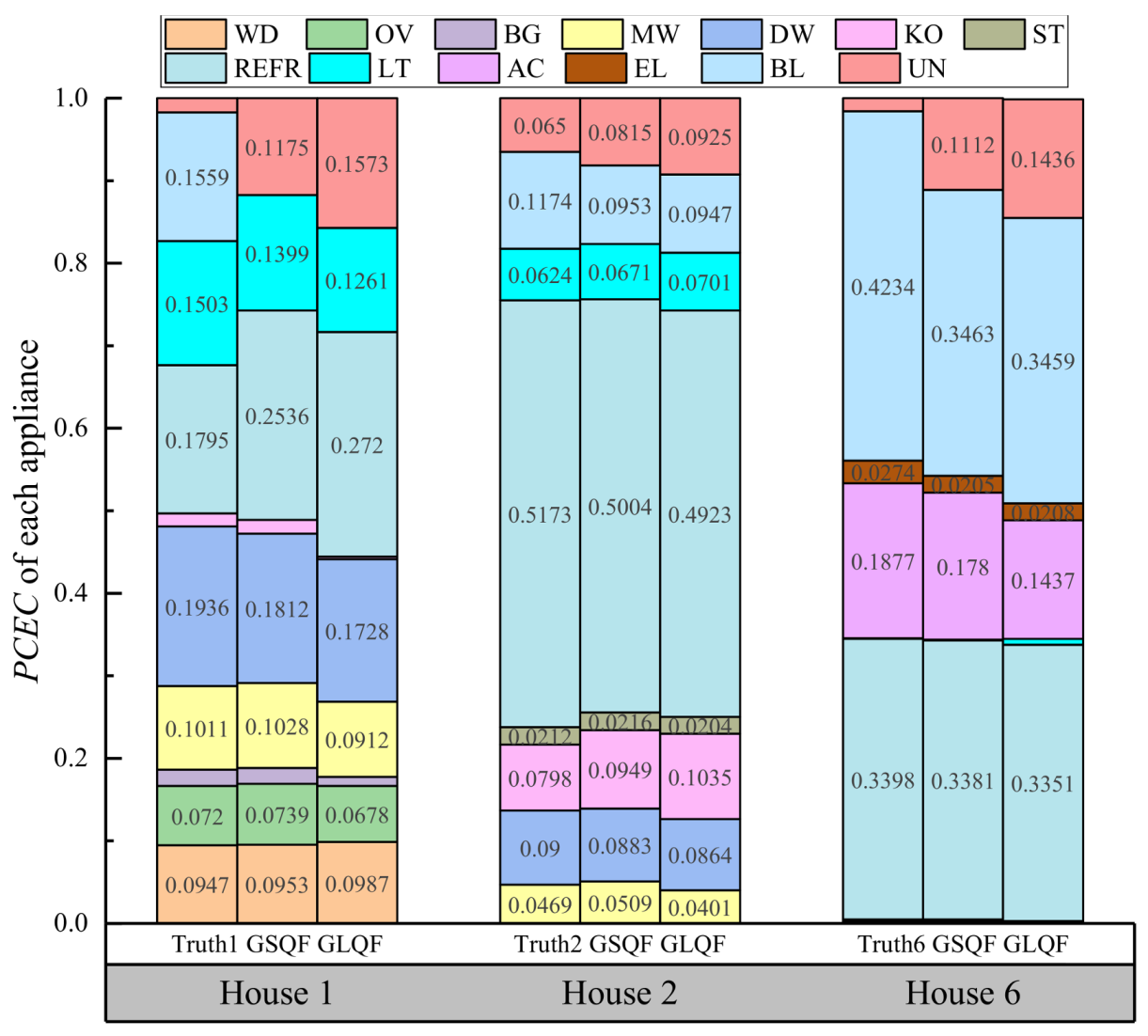
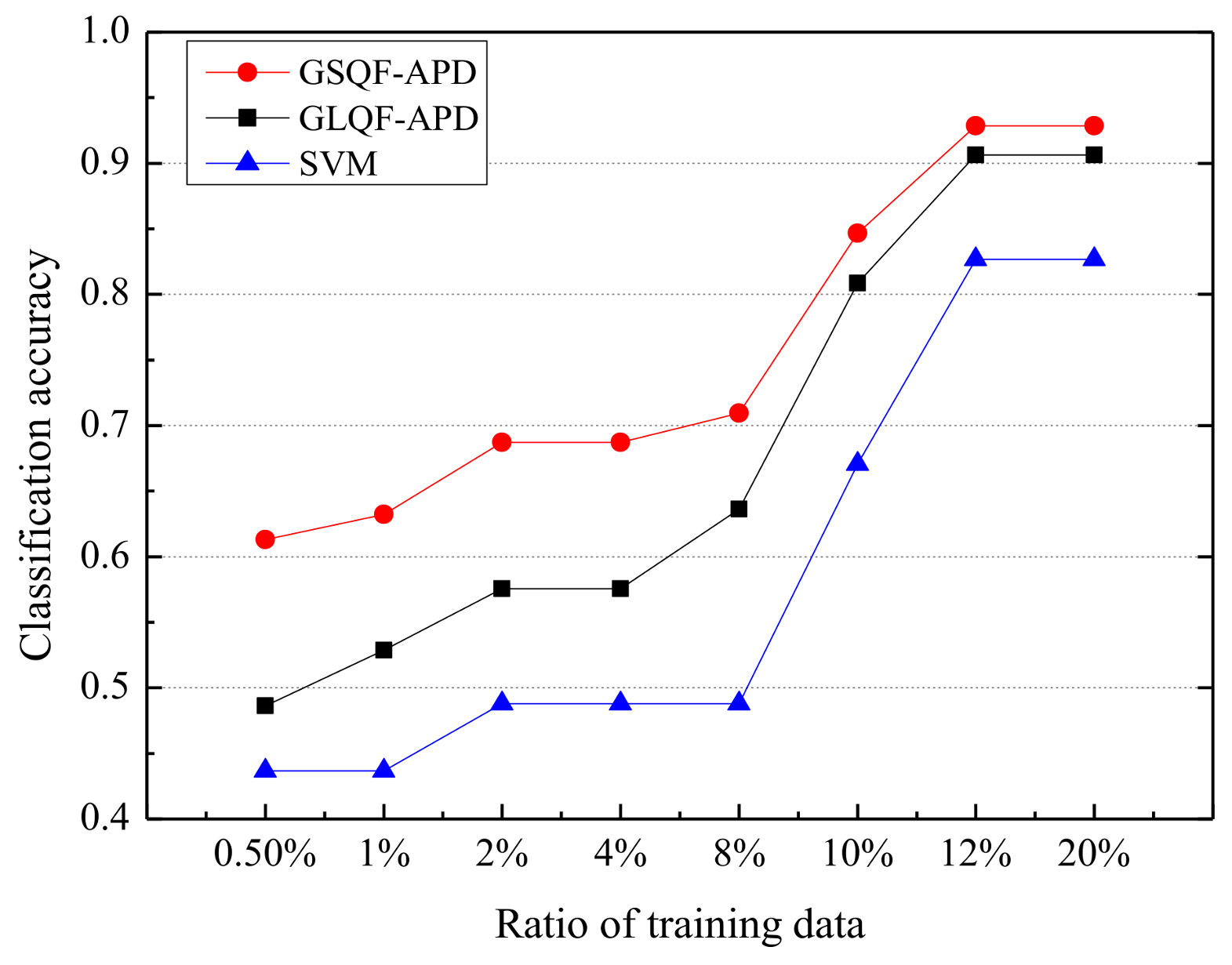
| Algorithm | Metric | MW | DW | KO2 | KO1 | ST | REFR | LT | ||
|---|---|---|---|---|---|---|---|---|---|---|
| GLQF-APD | Solution 1 | (I) | Pc (%) | 93.3 | 77.8 | 86.2 | 76.4 | 92.9 | 83.3 | INF |
| Solution 2 | (II) | 100 | 100 | 92.6 | 86.7 | 100 | 90.9 | INF | ||
| GSQF-APD | Step 1 | (III) | 93.8 | 72.7 | 84.4 | 73.7 | 80.0 | 81.5 | 33.3 | |
| Step 2 | (IV) | 94.1 | 81.8 | 87.9 | 82.4 | 89.5 | 89.6 | 44.4 | ||
| Improvement | (II)–(I) | ΔPc/Pc (%) | +7.2 | +28.5 | +7.4 | +13.5 | +7.6 | +9.1 | — | |
| (IV)–(III) | +0.3 | +12.5 | +4.1 | +11.8 | +11.8 | +9.9 | +33.3 | |||
| (IV)–(II) | −5.9 | −18.2 | −5.1 | −5.0 | −10.5 | −1.4 | — | |||
| GLQF-APD | Solution 1 | (I) | Rc (%) | 87.5 | 70.0 | 83.3 | 92.9 | 72.2 | 85.7 | 0 |
| Solution 2 | (II) | 87.5 | 70.0 | 83.3 | 92.9 | 72.2 | 85.7 | 0 | ||
| GSQF-APD | Step 1 | (III) | 93.8 | 80.0 | 90.0 | 100 | 88.9 | 96.2 | 75.0 | |
| Step 2 | (IV) | 100 | 90.0 | 96.7 | 100 | 94.4 | 98.1 | 100 | ||
| Improvement | (II)–(I) | ΔRc/Rc (%) | 0 | 0 | 0 | 0 | 0 | 0 | 0 | |
| (IV)–(III) | +6.6 | +12.5 | +7.4 | 0 | +6.2 | +2.0 | +33.3 | |||
| (IV)–(II) | +14.3 | +28.6 | +16.1 | +7.6 | +30.7 | +14.5 | — | |||
| GLQF-APD | Solution 1 | (I) | Fc (%) | 90.3 | 73.7 | 84.7 | 83.9 | 81.3 | 84.5 | INF |
| Solution 2 | (II) | 93.3 | 82.4 | 87.7 | 89.7 | 83.9 | 88.2 | INF | ||
| GSQF-APD | Step 1 | (III) | 93.8 | 76.2 | 87.1 | 84.8 | 84.2 | 88.2 | 46.2 | |
| Step 2 | (IV) | 97.0 | 85.7 | 92.1 | 90.3 | 91.9 | 93.6 | 61.5 | ||
| Improvement | (II)–(I) | ΔFc/Fc (%) | +3.3 | +11.8 | +3.5 | +6.9 | +3.2 | +4.4 | — | |
| (IV)–(III) | +3.4 | +12.5 | +5.7 | +6.5 | +9.1 | +6.1 | +33.1 | |||
| (IV)–(II) | +4.0 | +4.0 | +5.0 | +0.67 | +9.5 | +6.1 | — | |||
| Appliance | WD | OV | BG | MW | DW | KO | REFR | LT |
|---|---|---|---|---|---|---|---|---|
| FMP | 1 | 0.86 | 0.8 | 0.95 | 0.81 | 0.6 | 0.93 | 0.86 |
| FML | 0.91 | 0.85 | 0.5 | 0.92 | 0.62 | 0 | 0.9 | 0.75 |
| FMH | 0 | — | — | 0.5 | 0.13 | 0 | 0.97 | — |
| FMDT | 0.88 | — | — | 0.85 | 0.39 | 0.19 | 0.88 | — |
| Appliance | MW | DW | KO2 | KO1 | ST | REFR | LT |
|---|---|---|---|---|---|---|---|
| FMP | 0.97 | 0.86 | 0.92 | 0.9 | 0.92 | 0.94 | 0.62 |
| FML | 0.93 | 0.82 | 0.88 | 0.89 | 0.84 | 0.88 | 0 |
| FMH | 0.47 | 0.04 | 0.68 | 0.66 | 0.21 | 0.9 | — |
| FMDT | 0.97 | 0.32 | 0.92 | 0.91 | 0.33 | 0.97 | — |
| Appliance | ST | KO | AC | EL | REFR | LT |
|---|---|---|---|---|---|---|
| FMP | 1 | 1 | 0.86 | 1 | 0.98 | 1 |
| FML | 1 | 0.67 | 0.67 | 0.86 | 0.98 | 0.8 |
| FMH | 0 | 0 | 0.12 | 0.03 | 0.88 | — |
| FMDT | 0.67 | 0 | 0.89 | 0 | 0.99 | — |
© 2018 by the authors. Licensee MDPI, Basel, Switzerland. This article is an open access article distributed under the terms and conditions of the Creative Commons Attribution (CC BY) license (http://creativecommons.org/licenses/by/4.0/).
Share and Cite
Qi, B.; Liu, L.; Wu, X. Low-Rate Non-Intrusive Load Disaggregation with Graph Shift Quadratic Form Constraint. Appl. Sci. 2018, 8, 554. https://doi.org/10.3390/app8040554
Qi B, Liu L, Wu X. Low-Rate Non-Intrusive Load Disaggregation with Graph Shift Quadratic Form Constraint. Applied Sciences. 2018; 8(4):554. https://doi.org/10.3390/app8040554
Chicago/Turabian StyleQi, Bing, Liya Liu, and Xin Wu. 2018. "Low-Rate Non-Intrusive Load Disaggregation with Graph Shift Quadratic Form Constraint" Applied Sciences 8, no. 4: 554. https://doi.org/10.3390/app8040554
APA StyleQi, B., Liu, L., & Wu, X. (2018). Low-Rate Non-Intrusive Load Disaggregation with Graph Shift Quadratic Form Constraint. Applied Sciences, 8(4), 554. https://doi.org/10.3390/app8040554




